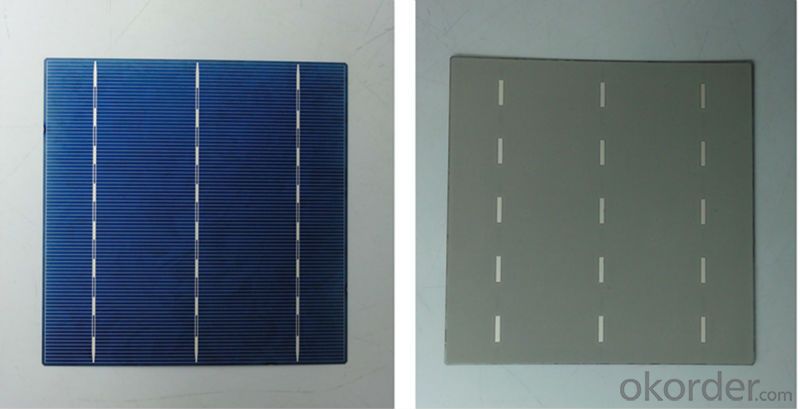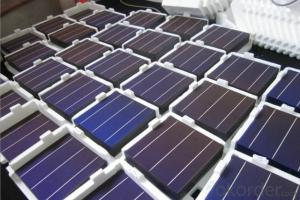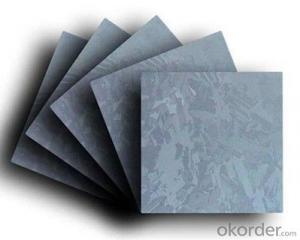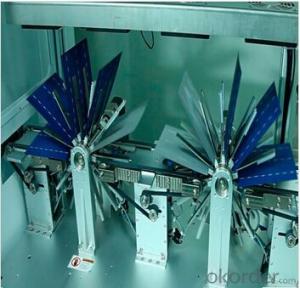Solar Cell High Quality A Grade Cell Monorystalline 5v 19.2%
- Loading Port:
- Shanghai
- Payment Terms:
- TT OR LC
- Min Order Qty:
- 1000 pc
- Supply Capability:
- 100000 pc/month
OKorder Service Pledge
OKorder Financial Service
You Might Also Like
Specifications
hot sale solar cell
1.16.8%~18.25% high efficiency
2.100% checked quality
3.ISO9001/ISO14001/TUV/CE/UL
4.stable performance
We can offer you the best quality products and services, don't miss !
POLY6'(156*156)
Polycrystalline Silicon Solar cell
Physical Characteristics
Dimension: 156mm×156mm±0.5mm
Diagonal: 220mm±0.5mm
Thickness(Si): 200±20 μm
Front(-) Back(+)
Blue anti-reflecting coating (silicon nitride); Aluminum back surface field;
1.5mm wide bus bars; 2.0mm wide soldering pads;
Distance between bus bars: 51mm . Distance between bus bars :51mm .
Electrical Characteristics
Efficiency(%) | 18.00 | 17.80 | 17.60 | 17.40 | 17.20 | 16.80 | 16.60 | 16.40 | 16.20 | 16.00 | 15.80 | 15.60 |
Pmpp(W) | 4.33 | 4.29 | 4.24 | 4.19 | 4.14 | 4.09 | 4.04 | 3.99 | 3.94 | 3.90 | 3.86 | 3.82 |
Umpp(V) | 0.530 | 0.527 | 0.524 | 0.521 | 0.518 | 0.516 | 0.514 | 0.511 | 0.509 | 0.506 | 0.503 | 0.501 |
Impp(A) | 8.159 | 8.126 | 8.081 | 8.035 | 7.990 | 7.938 | 7.876 | 7.813 | 7.754 | 7.698 | 7.642 | 7.586 |
Uoc(V) | 0.633 | 0.631 | 0.628 | 0.625 | 0.623 | 0.620 | 0.618 | 0.617 | 0.615 | 0.613 | 0.611 | 0.609 |
Isc(A) | 8.709 | 8.677 | 8.629 | 8.578 | 8.531 | 8.478 | 8.419 | 8.356 | 8.289 | 8.220 | 8.151 | 8.083 |

MONO5'(125*125mm)165
Monocrystalline silicon solar cell
Physical Characteristics
Dimension: 125mm×125mm±0.5mm
Diagonal: 165mm±0.5mm
Thickness(Si): 200±20 μm
Front(-) Back(+)
Blue anti-reflecting coating(silicon nitride); Aluminum back surface field;
1.6mmwide bus bars; 2.5mm wide soldering pads;
Distance between bus bars: 61mm . Distance between bus bars :61mm .
Electrical Characteristics
Efficiency(%) | 19.40 | 19.20 | 19.00 | 18.80 | 18.60 | 18.40 | 18.20 | 18.00 | 17.80 | 17.60 | 17.40 | 17.20 |
Pmpp(W) | 2.97 | 2.94 | 2.91 | 2.88 | 2.85 | 2.82 | 2.79 | 2.76 | 2.73 | 2.70 | 2.67 | 2.62 |
Umpp(V) | 0.537 | 0.535 | 0.533 | 0.531 | 0.527 | 0.524 | 0.521 | 0.518 | 0.516 | 0.515 | 0.513 | 0.509 |
Impp(A) | 5.531 | 5.495 | 5.460 | 5.424 | 5.408 | 5.382 | 5.355 | 5.328 | 5.291 | 5.243 | 5.195 | 4.147 |
Uoc(V) | 0.637 | 0.637 | 0.636 | 0.635 | 0.633 | 0.630 | 0.629 | 0.629 | 0.628 | 0.626 | 0.626 | 0.625 |
Isc(A) | 5.888 | 5.876 | 5.862 | 5.848 | 5.839 | 5.826 | 5.809 | 5.791 | 5.779 | 5.756 | 5.293 | 5.144 |

FAQ:
Q:How can i get some sample?
A:Yes , if you want order ,sample is not a problem.
Q:How about your solar panel efficency?
A: Our product efficency around 17.25%~18.25%.
Q:What’s the certificate you have got?
A: we have overall product certificate of ISO9001/ISO14001/CE/TUV/UL
- Q:What is the impact of light-induced degradation on the performance of solar silicon wafers?
- Light-induced degradation refers to the phenomenon where the performance of solar silicon wafers decreases over time due to exposure to sunlight. This degradation primarily affects the efficiency of the solar cells and reduces their power output. It occurs due to the formation of defects and impurities within the silicon material, which reduces the ability of the solar cells to convert sunlight into electricity. To mitigate this impact, manufacturers employ various techniques such as passivation layers or anti-reflective coatings to minimize light-induced degradation and ensure optimal performance of solar silicon wafers.
- Q:What is the average lifespan of a solar silicon wafer?
- The average lifespan of a solar silicon wafer can vary depending on various factors such as the quality of the wafer, the manufacturing process, and the conditions in which it is used. However, on average, a solar silicon wafer can last anywhere from 25 to 30 years.
- Q:How does the thickness of a front contact affect the efficiency of a solar silicon wafer?
- The thickness of a front contact on a solar silicon wafer can affect its efficiency by influencing the amount of light that can penetrate the wafer. A thicker front contact can absorb more light, but it can also increase the resistance and reflectivity, leading to losses. Therefore, finding an optimal thickness is crucial to balance light absorption and electrical performance, ultimately maximizing the efficiency of the solar silicon wafer.
- Q:How efficient are solar silicon wafers in converting sunlight into electricity?
- Solar silicon wafers are highly efficient in converting sunlight into electricity. With advancements in technology, the average efficiency of silicon-based solar panels has reached around 20%-25%. This means that approximately 20%-25% of the sunlight falling on the solar panels is converted into usable electricity. However, ongoing research and development aim to improve the efficiency of solar silicon wafers even further, making them an increasingly effective and sustainable source of energy.
- Q:What are the different manufacturing processes for solar silicon wafers?
- The different manufacturing processes for solar silicon wafers include crystallization, wafering, texturization, doping, passivation, and metallization.
- Q:How does the efficiency of a solar silicon wafer change with humidity?
- The efficiency of a solar silicon wafer typically decreases with increasing humidity. This is because higher humidity levels can lead to the formation of a thin layer of moisture on the surface of the wafer, which can reduce its ability to absorb sunlight effectively. Additionally, moisture can also contribute to electrical losses within the wafer, further decreasing its efficiency.
- Q:How do solar silicon wafers perform in dusty environments?
- Solar silicon wafers typically perform well in dusty environments due to their smooth and flat surfaces. However, excessive dust accumulation can decrease their efficiency over time, requiring regular cleaning to maintain optimal performance.
- Q:How are solar silicon wafers protected from handling errors during installation?
- Solar silicon wafers are protected from handling errors during installation through several measures. Firstly, they are typically packaged in protective materials such as anti-static bags or foam to prevent any physical damage or electrostatic discharge. Additionally, during installation, special handling techniques are employed to minimize the risk of mishandling or dropping the wafers. These techniques may include using cleanroom gloves, avoiding direct contact with the wafers' active surfaces, and using precision tools or equipment for their placement. Overall, these precautions aim to safeguard the delicate wafers and ensure their proper installation without any handling errors.
- Q:What is the purpose of a grounding wire in a solar silicon wafer?
- The purpose of a grounding wire in a solar silicon wafer is to provide a safe path for electrical current to flow in case of a fault or malfunction. This helps to protect the equipment and prevent electrical shocks or damage.
- Q:How do solar silicon wafers perform in high humidity conditions?
- Solar silicon wafers generally perform well in high humidity conditions. The wafers themselves are typically made of highly durable materials, such as crystalline silicon, which are not easily affected by moisture. However, excessive humidity can potentially cause a slight decrease in the efficiency of solar panels due to water vapor absorbing some sunlight before it reaches the silicon wafer. Nonetheless, modern solar panel designs and protective coatings help minimize any negative impact, ensuring efficient operation even in high humidity environments.
1. Manufacturer Overview |
|
|---|---|
| Location | |
| Year Established | |
| Annual Output Value | |
| Main Markets | |
| Company Certifications | |
2. Manufacturer Certificates |
|
|---|---|
| a) Certification Name | |
| Range | |
| Reference | |
| Validity Period | |
3. Manufacturer Capability |
|
|---|---|
| a)Trade Capacity | |
| Nearest Port | |
| Export Percentage | |
| No.of Employees in Trade Department | |
| Language Spoken: | |
| b)Factory Information | |
| Factory Size: | |
| No. of Production Lines | |
| Contract Manufacturing | |
| Product Price Range | |
Send your message to us
Solar Cell High Quality A Grade Cell Monorystalline 5v 19.2%
- Loading Port:
- Shanghai
- Payment Terms:
- TT OR LC
- Min Order Qty:
- 1000 pc
- Supply Capability:
- 100000 pc/month
OKorder Service Pledge
OKorder Financial Service
Similar products
New products
Hot products
Related keywords


























